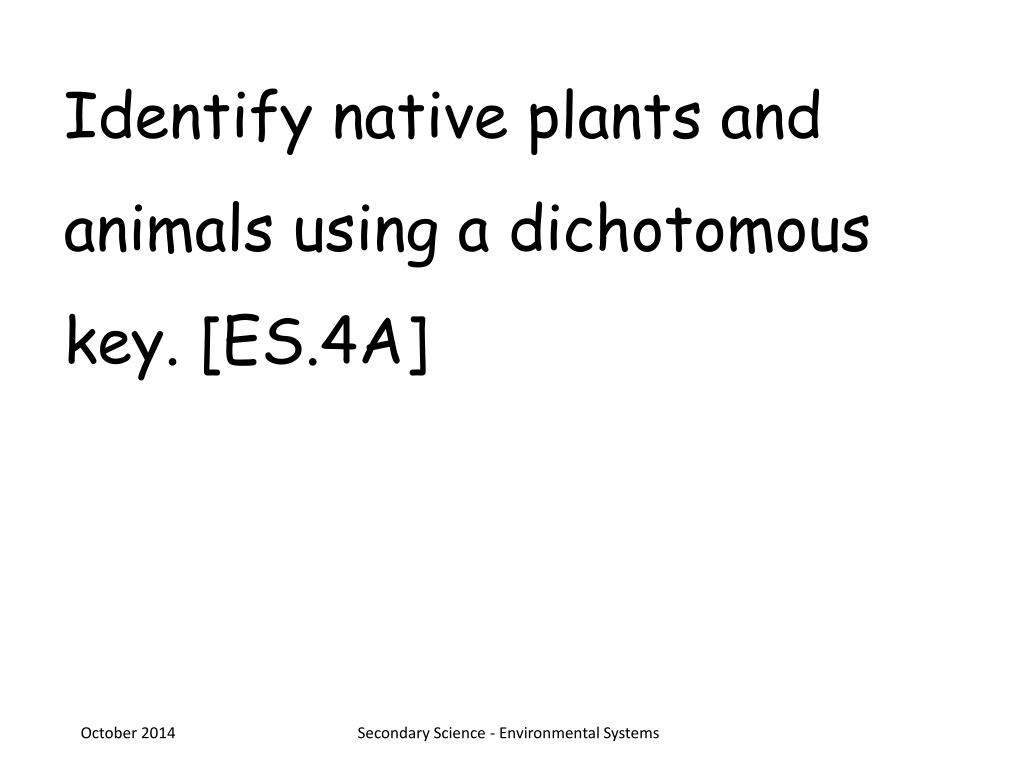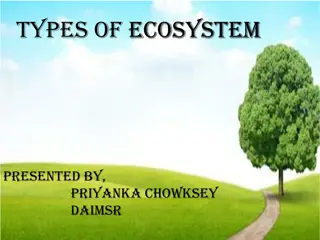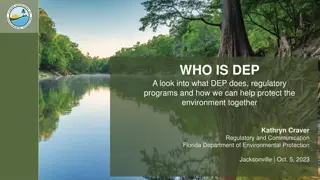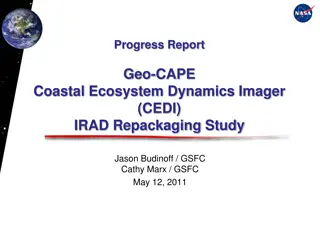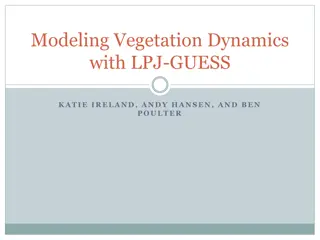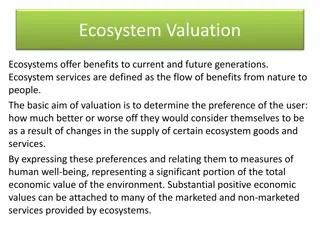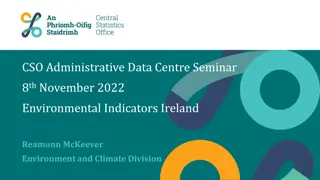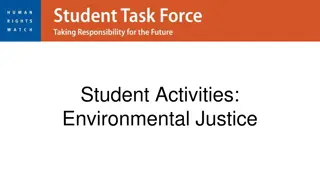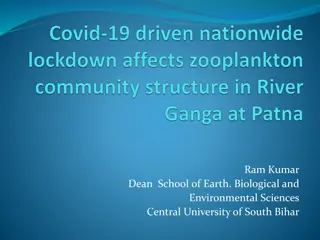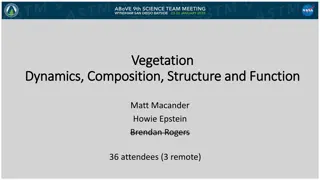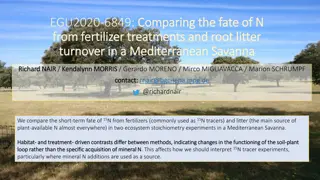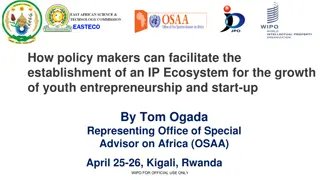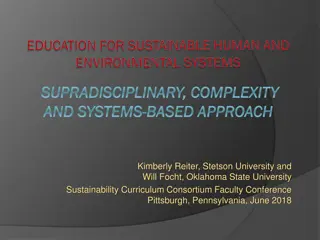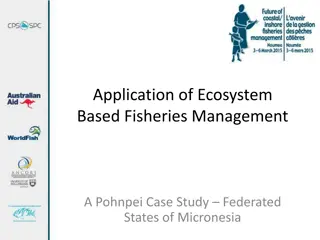Exploring Ecosystem Dynamics: Environmental Systems Study
In this Environmental Systems study, students delve into identifying native plants and animals using a dichotomous key, assessing their roles within local ecosystems, and comparing them to other biomes. They also analyze abiotic cycles such as rock, hydrologic, carbon, and nitrogen cycles, and evaluate the effects of abiotic factors on ecosystems. Additionally, they measure concentrations of solutes and solvents, predict impacts of invasive species introduction or removal, and explore how species extinction may alter food chains. Researching causes of species diversity and predicting ecosystem changes due to genetic diversity fluctuations are also focal points.
Uploaded on Sep 27, 2024 | 0 Views
Download Presentation

Please find below an Image/Link to download the presentation.
The content on the website is provided AS IS for your information and personal use only. It may not be sold, licensed, or shared on other websites without obtaining consent from the author. Download presentation by click this link. If you encounter any issues during the download, it is possible that the publisher has removed the file from their server.
E N D
Presentation Transcript
Identify native plants and animals using a dichotomous key. [ES.4A] October 2014 Secondary Science - Environmental Systems
Assess the role of native plants and animals within a local ecosystem, and compare them to plants and animals in ecosystems within four other biomes. [ES 4.B] October 2014 Secondary Science - Environmental Systems
Diagram abiotic cycles including the rock, hydrologic, carbon, and nitrogen cycle. [ES 4.C] October 2014 Secondary Science - Environmental Systems
Make observations and compile data about fluctuations in abiotic cycles and evaluate the effects of abiotic factors on local ecosystems and local biomes. [ES 4.D] October 2014 Secondary Science - Environmental Systems
Measure the concentration of solute, solvent, and solubility of dissolved substances such as dissolved oxygen, chlorides, and nitrates and describe their impact on an ecosystem. [ES 4.E] October 2014 Secondary Science - Environmental Systems
Predict how the introduction or removal of an invasive species may alter the food chain and affect existing populations in an ecosystem. [ES 4.F] October 2014 Secondary Science - Environmental Systems
Predict how species extinction may alter the food chain and affect existing populations in an ecosystem. [ES 4.G] October 2014 Secondary Science - Environmental Systems
Research and explain the causes of species diversity and predict changes that may occur in an ecosystem if species and genetic diversity is increased or reduced. [ES 4.H] October 2014 Secondary Science - Environmental Systems
Summarize methods of land use and management, and describe its effect on land fertility. [ES 5.A] October 2014 Secondary Science - Environmental Systems
Identify source, use, quality, management, and conservation of water. [ES 5.B] October 2014 Secondary Science - Environmental Systems
Document the use and conservation of both renewable and non-renewable resources as they pertain to sustainability. [ES 5.B] October 2014 Secondary Science - Environmental Systems
Identify renewable and non- renewable resources that must come from outside an ecosystem such as food, water, lumber, and energy. [ES 5.C] October 2014 Secondary Science - Environmental Systems
Analyze and evaluate the economic significance and interdependence of resources within the environmental system. [ES 5.E] October 2014 Secondary Science - Environmental Systems
Evaluate the impact of waste management methods such as reduction, reuse, recycling, and composting on resource availability. [ES 5.F] October 2014 Secondary Science - Environmental Systems
Define and identify the components of the geosphere, hydrosphere, cryosphere, atmosphere, and biosphere and the interactions among them. [ES 6.A] October 2014 Secondary Science - Environmental Systems
Describe and compare renewable and nonrenewable energy derived from natural and alternative sources such as oil, natural gas, coal, nuclear, solar, geothermal, hydroelectric, and wind. [ES 6.B] October 2014 Secondary Science - Environmental Systems
Explain the flow of energy in an ecosystem including conduction, convection and radiation. [ES 6.C] October 2014 Secondary Science - Environmental Systems
Investigate and explain the effects of energy transformations in terms of the laws of thermodynamics within an ecosystem. [ES 6.D] October 2014 Secondary Science - Environmental Systems
Investigate and identify energy interactions in an ecosystem. (ES 6.E) October 2014 Secondary Science - Environmental Systems
Relate carrying capacity to population dynamics. [ES 7.A] October 2014 Secondary Science - Environmental Systems
Calculate birth rate exponential growth of populations. [ES 7.B] October 2014 Secondary Science - Environmental Systems
Analyze and predict the effects of non-renewable resource depletion. [ES 7.C] October 2014 Secondary Science - Environmental Systems
Analyze and make predictions about the impact on populations of geographic locales due to diseases, birth and death rates, urbanization, and natural events, such as migration and seasonal changes. [ES 7.D] October 2014 Secondary Science - Environmental Systems
Analyze and describe the effects on areas impacted by natural events such as tectonic movement, volcanic events, fires, tornados, hurricanes, flooding, tsunamis, and population growth. [ES 8.A] October 2014 Secondary Science - Environmental Systems
Explain how regional changes in the environment may have a global effect. [ES 8.B] October 2014 Secondary Science - Environmental Systems
Examine how natural processes such as succession and feedback loops restore habitats and ecosystems. [ES 8.C] October 2014 Secondary Science - Environmental Systems
Describe how temperature inversions impact weather conditions including El Ni o and La Ni a oscillations. [ES 8.D] October 2014 Secondary Science - Environmental Systems
Analyze the impact of temperature inversions on global warming, icecap and glacial melting, and changes in ocean currents and surface temperatures. [ES 8.E] October 2014 Secondary Science - Environmental Systems
Identify causes of air, soil and water pollution including point and nonpoint sources. [ES 9.A] October 2014 Secondary Science - Environmental Systems
Investigate the types of air, soil, and water pollution such as chlorofluorocarbons, carbon dioxide, pH, pesticide runoff, thermal variations, metallic ions, heavy metals and nuclear waste. [ES 9.B] October 2014 Secondary Science - Environmental Systems
Examine the concentrations of air, soil, and water pollutants using appropriate units. [ES 9.C] October 2014 Secondary Science - Environmental Systems
Describe the effect of pollution on global warming, glacial/ice cap melting, greenhouse effect, ozone layer, and aquatic viability. [ES 9.D] October 2014 Secondary Science - Environmental Systems
Evaluate the effect of human activities including habitat restoration projects, species preservation efforts, nature conservancy groups, hunting, fishing, ecotourism, all terrain vehicles, and small personal water craft on the environment. [ES 9.E] October 2014 Secondary Science - Environmental Systems
Evaluate cost-benefit trade- offs of commercial activities such as municipal development, farming, deforestation, over- harvesting, and mining. [ES 9.F] October 2014 Secondary Science - Environmental Systems
Analyze how ethical beliefs can be used to influence scientific practices such as methods for increasing food production. [ES 9.G] October 2014 Secondary Science - Environmental Systems
Analyze and evaluate different views on the existence of global warming. [ES 9.H] October 2014 Secondary Science - Environmental Systems
Discuss the impact of research and technology on social ethics and legal practices in situations such as the design of new buildings, recycling, or emission standards. [ES 9.I] October 2014 Secondary Science - Environmental Systems
Research the advantages and disadvantages of "going green" such as organic gardening and farming, natural methods of pest control, hydroponics, xeriscaping, energy- efficient homes and appliances, and hybrid cars. [ES 9.J] October 2014 Secondary Science - Environmental Systems
Analyze past and present local, state, and national legislation, including Texas automobile emissions regulations, the National Park Service Act, the Clean Air Act, the Clean Water Act, the Soil and Water Resources Conservation Act, and the Endangered Species Act. [ES 9.K] October 2014 Secondary Science - Environmental Systems
Analyze past and present international treaties and protocols such as the environmental Antarctic Treaty System, Montreal Protocol, and Kyoto Protocol. [ES 9.L] October 2014 Secondary Science - Environmental Systems
